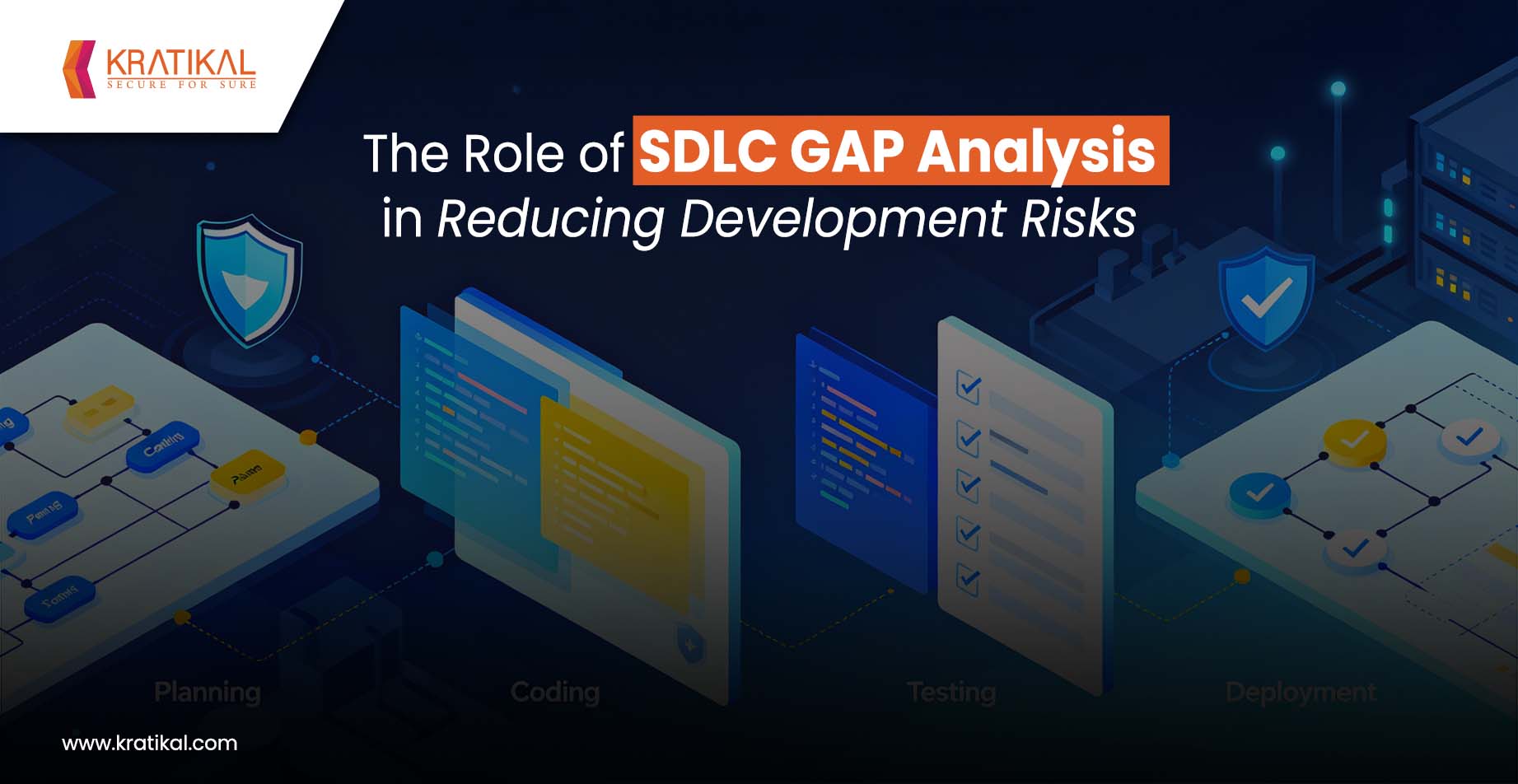In the race to build and release software faster, many organizations unintentionally overlook one critical aspect: security and process integrity within the Software Development Life Cycle (SDLC). Every missed control or overlooked best practice in the SDLC can lead to significant risks from vulnerabilities and compliance failures to project delays and increased costs. To mitigate these risks, organizations are turning to SDLC Gap Analysis, a structured approach that identifies weaknesses in the current development process and bridges them with effective controls. This proactive step ensures that software is not only functional and efficient but also secure, compliant, and resilient.
Table of Contents
Understanding SDLC and SDLC Gap Analysis
The Software Development Life Cycle (SDLC) is a structured process that guides how software is planned, developed, tested, and maintained. It ensures that every stage from requirement gathering to deployment follows consistent and measurable steps.
SDLC Gap Analysis goes one level deeper. It involves evaluating your existing development lifecycle to identify areas where practices, policies, or controls fall short of desired standards.
Essentially, it compares the current state of your SDLC against an ideal secure and optimized model, exposing gaps that could lead to inefficiencies, vulnerabilities, or non-compliance.
How SDLC Gap Analysis Helps Minimise Development Risks?
Software development today is more complex than ever before. With multiple teams, technologies, and compliance requirements in play, even minor gaps in the Software Development Life Cycle (SDLC) can lead to significant security vulnerabilities, project delays, or compliance failures. That’s where SDLC Gap Analysis comes into the picture, serving as a structured approach to identify, assess, and bridge process gaps that may otherwise go unnoticed.
An effective SDLC Gap Analysis helps organizations align their development practices with security standards, improve collaboration between teams, and ensure high-quality software delivery with minimal risks. Let’s explore how it contributes to reducing development risks across the lifecycle.
Identifies Weak Links in Early Development Lifecycle
One of the most powerful advantages of SDLC Gap Analysis is its ability to uncover weaknesses in the early stages of development. It examines every phase, from planning and requirements gathering to deployment, to identify missing controls, unclear processes, or potential inefficiencies.
By addressing these issues early, organizations can prevent minor flaws from evolving into critical vulnerabilities or design defects later in the cycle. This proactive approach not only reduces development risks but also saves valuable time and resources that would otherwise be spent on rework and debugging.
Strengthens Security At Every Stage
Security is often treated as an afterthought, assessed only during the testing or deployment phase. SDLC Gap Analysis changes that narrative by embedding security across all stages of the development lifecycle. It pinpoints where security measures are lacking — whether in code review processes, access control, data handling, or third-party integrations.
By integrating security checks and validation points throughout the SDLC, organizations can develop applications that are secure by design. This shift-left approach ensures vulnerabilities are identified and resolved before deployment, significantly minimizing the risk of cyberattacks and data breaches.
Improves Risk Visibility and Decision Making
Without proper visibility into risks across the development lifecycle, decision-making often becomes reactive rather than strategic. SDLC Gap Analysis changes that by offering a clear overview of all potential risk areas, technical, operational, or procedural.
Quantifying and categorizing risks based on their severity and potential impact gives teams a clear perspective on where vulnerabilities exist and which issues demand immediate action. This structured insight enables leadership to make informed, data-driven decisions, optimize resource allocation, and implement targeted risk mitigation strategies. The outcome is a stronger, more resilient software product with significantly reduced exposure to potential threats.
Enhances Collaboration and Process Clarity
Software development involves multiple stakeholders, developers, testers, security teams, and project managers. Miscommunication or unclear responsibilities can lead to missed deadlines, duplicated efforts, and increased risks.
SDLC Gap Analysis fosters collaboration by defining clear roles, responsibilities, and checkpoints for each stage. It ensures that everyone involved understands their part in maintaining code quality and security standards. As a result, communication improves, workflows become more efficient, and teams work in greater alignment toward shared goals.
Get in!
Join our weekly newsletter and stay updated
Why Does SDLC Gap Analysis Matter?
A well-structured SDLC ensures secure and efficient software delivery, but without periodic gap analysis, unseen vulnerabilities and process flaws can easily slip through.
Strengthens Security Across All Phases
Security is most effective when integrated into every stage of software development.
Through gap analysis, organizations can pinpoint weak links such as a lack of code review processes, an absence of threat modeling, or insufficient vulnerability testing. By addressing these issues early, development teams can drastically reduce the chances of introducing exploitable flaws into production.
Ensuring Compliance with Industry Standards
An SDLC Gap Analysis helps organizations verify whether their current processes align with these standards.
By analyzing policies, audit trails, and security testing mechanisms, teams can ensure their development pipeline is compliant with both regulatory and internal governance requirements. This proactive assessment not only minimizes legal or financial penalties but also streamlines audits and certification processes.
Enhance Risk Management and Visibility
An SDLC Gap Analysis provides a holistic view of where process weaknesses and security lapses exist. It allows organizations to prioritize remediation based on severity and potential business impact. By converting unknown risks into known and measurable ones, decision-makers gain better visibility and control over the development ecosystem.
Reduces Costs Through Detection
Addressing vulnerabilities during the design or development phase is exponentially cheaper than fixing them post-deployment. By identifying gaps at the start, organizations can save significant resources, reduce rework, and minimize the likelihood of costly cyber incidents.
Improves Overall Product Quality
Gap analysis doesn’t just focus on security; it enhances the overall quality of the product. By enforcing structured testing, better documentation, and process consistency, it ensures that the software meets not only technical but also usability and performance standards. The result is a secure, stable, and high-performing product that earns user trust.
Book Your Free Cybersecurity Consultation Today!
How Kratikal Can Help Organziations in SDLC Gap Analysis?
Kratikal helps organizations strengthen their software development lifecycle through a structured and practical SDLC Gap Analysis. Their experts first assess your existing SDLC processes to spot weak points, missing controls, and compliance gaps, then craft a clear roadmap to fix them. From defining remediation priorities to helping implement new policies and embedding security into each stage of development, Kratikal ensures your teams don’t just identify risks, they actually resolve them. The result is a more secure, compliant, and efficient development process that reduces rework, enhances software quality, and keeps your organization audit-ready year-round.
FAQs
- How does gap analysis contribute to risk management?
Gap analysis helps pinpoint areas where a business may be lacking, enabling more informed and strategic decisions to mitigate potential risks. It supports risk avoidance, a proactive approach organizations use to reduce the likelihood or impact of identified threats before they escalate.
- What is the purpose of gap analysis?
The gap analysis process enables organizations to understand what’s needed to achieve their business objectives. By comparing the current and desired states, it uncovers existing deficiencies and highlights opportunities for improvement.







Leave a comment
Your email address will not be published. Required fields are marked *